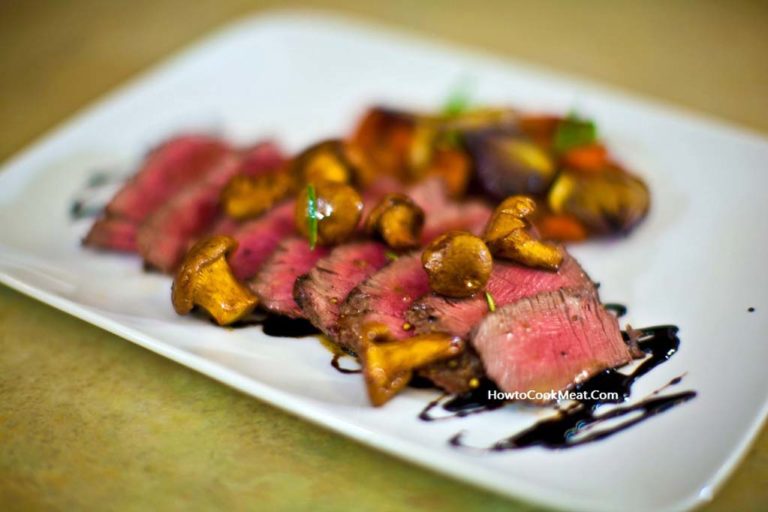
Chef's notes:
The English translation of mignon is dainty or cute. So, what do we do with a dainty cut of meat? When I think of dainty things, I think of delicate, small, or even lacy things. I suppose that meat could only be considered delicate in terms of cooking, or more specifically in terms of the greater risk of overcooking. Also, the tenderloin itself can be difficult to remove because the muscle is not strong and tears easily. It must be carefully cut from the bones to remove it. So, in that way, filet mignon is the most delicate or dainty of all the meats.
Ingredients
- 2 filet mignons
- Sea salt
- Black pepper
Broiled Filet Mignon with Sea Salt and Pepper, Broiled and Served with Chanterelle Butter and Balsamic Reduction
- Pick up some nice, thick filet mignon. The beautiful part about a filet mignon is that it is the tenderest cut from the tenderest part of a cow: the tenderloin. This means that you don’t really have to do much to it, and that includes when cooking. However, we still want it to get brown and crispy on the outside, which is why we buy thick-cut steaks and cook them quickly in a very hot broiler.
- Season the filet mignon with salt and pepper. Since beef tenderloin and filet mignon taste great naturally, we also don’t need to season them much. A nice sea salt will bring out the flavor already present, and a little black pepper will give it depth. There are many choices when it comes to salt (sel gris, fleur de sel, alaea salt), but more often than not, I just use a simple sea salt.
- Broil the first side of the filet mignon. Heat up the broiler on high for a few minutes before putting the meat underneath it. Also, move the top oven rack to the second position from the top. This will allow the heat time to spread evenly. Try to place the meat on the broiling pan so the heat is evenly distributed from above. After a few minutes, they should begin to get brown and crispy. Be sure to keep an eye on the filet as they cook, as they will begin to burn quickly.
- After broiling the second side, rest the filet mignon. I usually give the first side about 6 minutes under the broiler before flipping. Use a digital thermometer to determine internal temp. Cooking temps for the filet should be: rare 120–125 degrees F, medium-rare 130–140, medium 140–150, medium-well 150–160, and well-done 160+. Of course, if you cook a filet mignon past medium, the Gendarme will come and beat you silly. Before you eat your filet, let it rest for five minutes, as I’ve shown in the photo.
Tips & Tricks
- Even though true filet mignons are cut from the small end of the tenderloin, buy the nice, thick ones that look like they will cook evenly. The little ones will taste good, too, but they will come out better in a frying pan than they will under a broiler.
- Some filets come frozen in sealed plastic bags. Once thawed, get them out of the bag soon. You don’t want them sitting in their own melted juice.
- If you are unfamiliar with broiling, watch the filets as they cook, but don’t touch them. If they look like they are getting way overcooked in some spots, but undercooked in others, you are too close to the broiler. If it’s been 5 minutes and they still look raw, your pan is too far away from the coil, or your broiler is kaput.
- It is nice to cut the filet thinly and splay them out when serving. Especially if you are using a plate sauce like the balsamic reduction, or you are serving them with chanterelles and butter.
- I can not stress enough that chanterelles should only be cooked for a few seconds. In those few seconds, they make the butter taste like heaven, and the butter makes them taste like Jesus in heaven. But they are still firm, barely cooked. That is absolutely the way you want them. Trust me.
Chanterelle Butter Recipe
- 3 Tbsp salted butter
- 1 pint fresh chanterelles
- 1 tsp minced rosemary
Melt the butter over medium heat. Toss in the rosemary and chanterelles, coat with the butter, and fry for a few seconds. Remove from the heat and place atop the steak.
